Business Finance Tutorial Questions Assignment Solutions - HC2091
VerifiedAdded on 2023/01/10
|7
|1057
|94
Homework Assignment
AI Summary
This document offers comprehensive solutions to a Business Finance assignment, addressing key concepts from the course HC2091. The assignment delves into various aspects of financial management, starting with the calculation of bond coupon payments and the relationship between share prices and investor required rates of return. It then proceeds to analyze portfolio returns, including calculations for arithmetic average returns and portfolio weights. The assignment also covers the valuation of a firm, capital structure weights, and the weighted average cost of capital. Furthermore, it explores the topic of venture capital, including considerations for selecting venture capitalists and managing cash flow, analyzing operating and cash cycles.
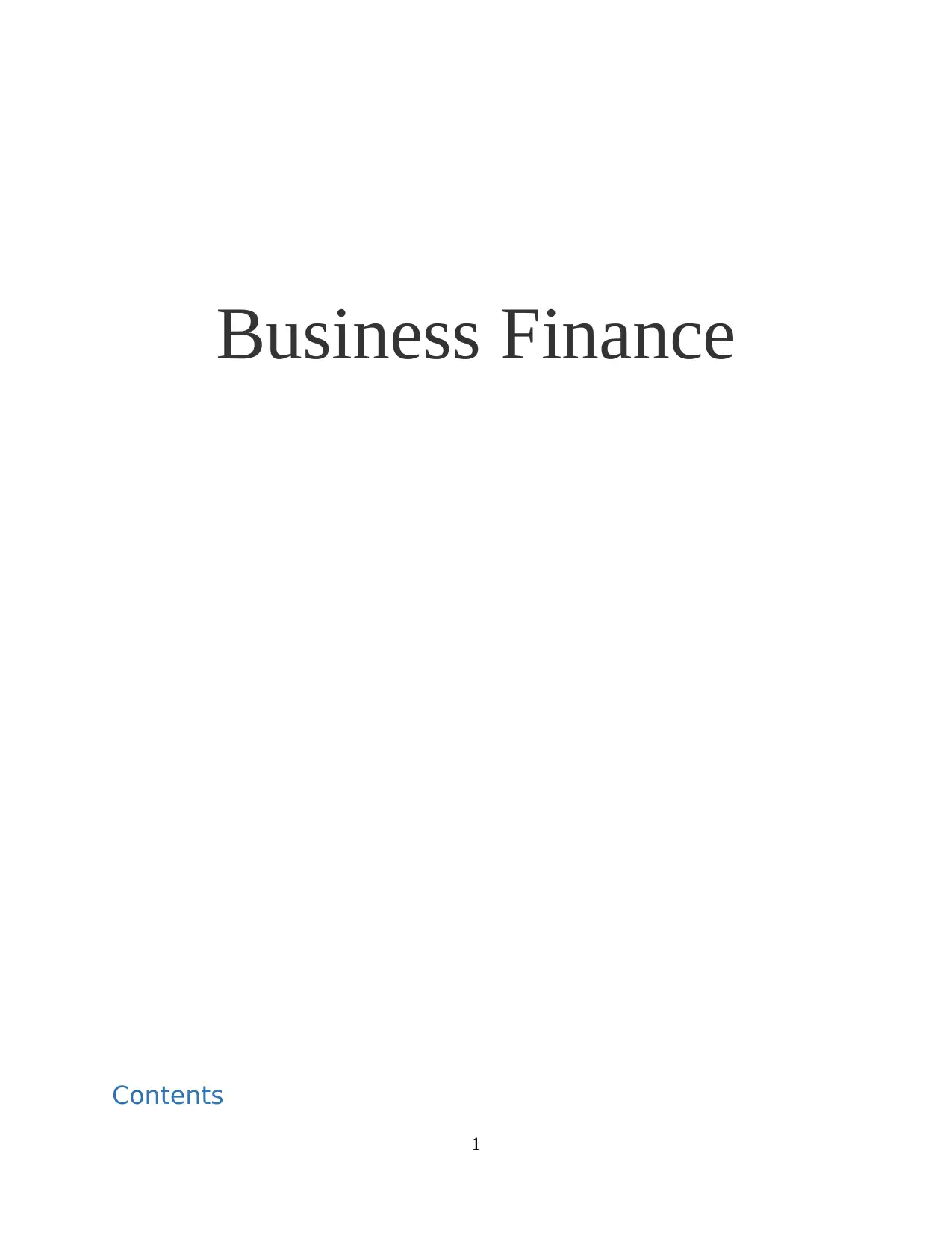
Business Finance
Contents
1
Contents
1
Paraphrase This Document
Need a fresh take? Get an instant paraphrase of this document with our AI Paraphraser
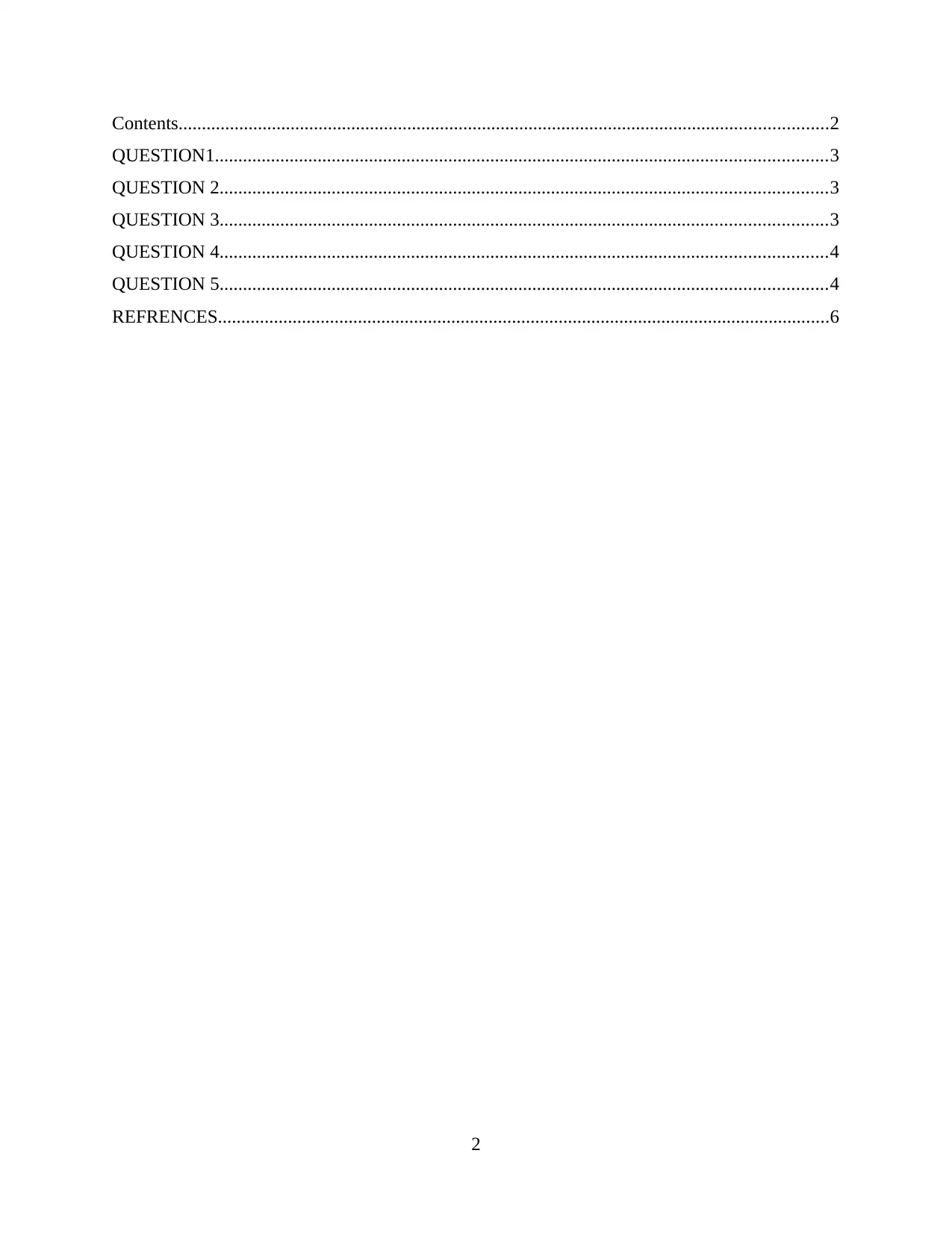
Contents...........................................................................................................................................2
QUESTION1...................................................................................................................................3
QUESTION 2..................................................................................................................................3
QUESTION 3..................................................................................................................................3
QUESTION 4..................................................................................................................................4
QUESTION 5..................................................................................................................................4
REFRENCES...................................................................................................................................6
2
QUESTION1...................................................................................................................................3
QUESTION 2..................................................................................................................................3
QUESTION 3..................................................................................................................................3
QUESTION 4..................................................................................................................................4
QUESTION 5..................................................................................................................................4
REFRENCES...................................................................................................................................6
2
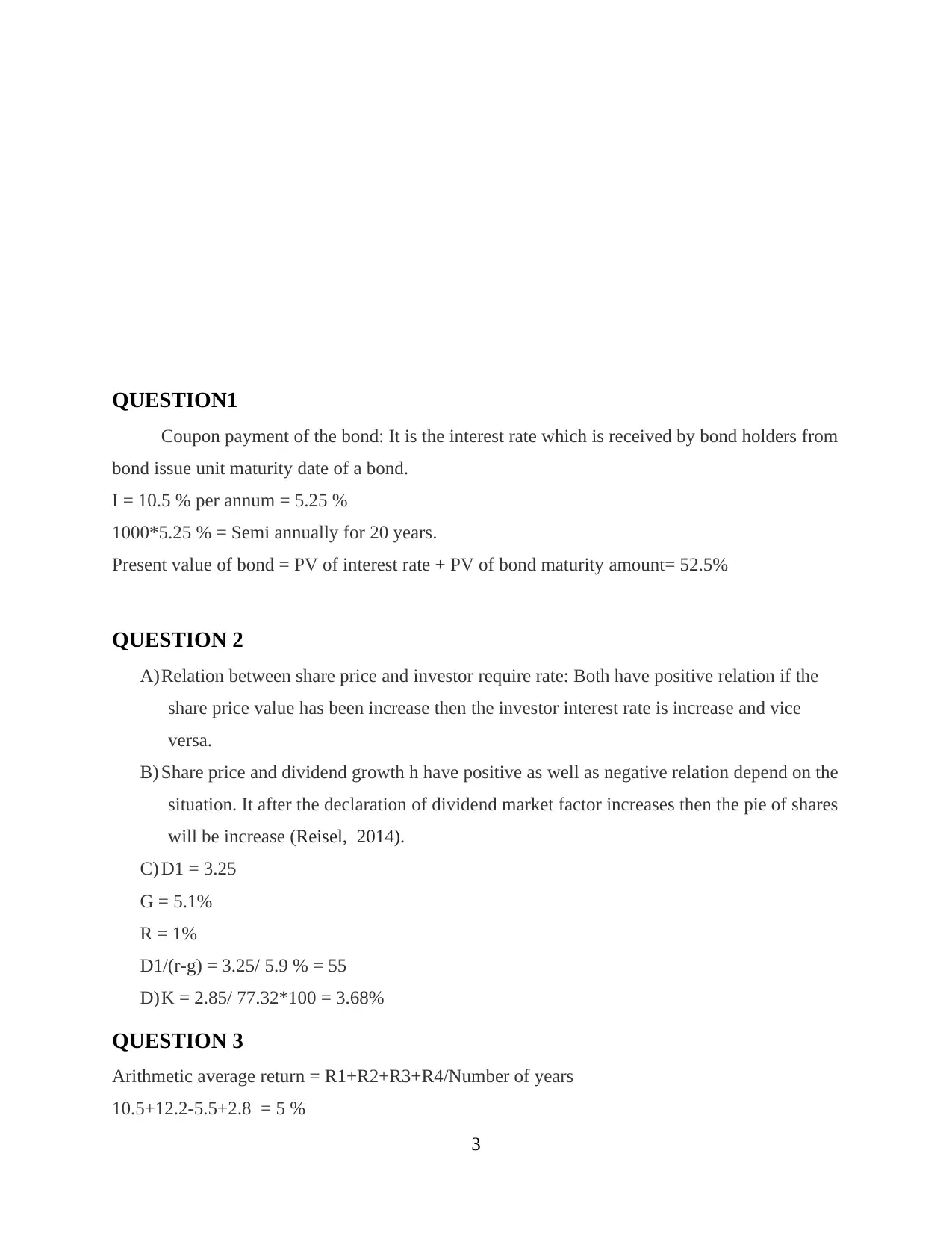
QUESTION1
Coupon payment of the bond: It is the interest rate which is received by bond holders from
bond issue unit maturity date of a bond.
I = 10.5 % per annum = 5.25 %
1000*5.25 % = Semi annually for 20 years.
Present value of bond = PV of interest rate + PV of bond maturity amount= 52.5%
QUESTION 2
A)Relation between share price and investor require rate: Both have positive relation if the
share price value has been increase then the investor interest rate is increase and vice
versa.
B) Share price and dividend growth h have positive as well as negative relation depend on the
situation. It after the declaration of dividend market factor increases then the pie of shares
will be increase (Reisel, 2014).
C) D1 = 3.25
G = 5.1%
R = 1%
D1/(r-g) = 3.25/ 5.9 % = 55
D)K = 2.85/ 77.32*100 = 3.68%
QUESTION 3
Arithmetic average return = R1+R2+R3+R4/Number of years
10.5+12.2-5.5+2.8 = 5 %
3
Coupon payment of the bond: It is the interest rate which is received by bond holders from
bond issue unit maturity date of a bond.
I = 10.5 % per annum = 5.25 %
1000*5.25 % = Semi annually for 20 years.
Present value of bond = PV of interest rate + PV of bond maturity amount= 52.5%
QUESTION 2
A)Relation between share price and investor require rate: Both have positive relation if the
share price value has been increase then the investor interest rate is increase and vice
versa.
B) Share price and dividend growth h have positive as well as negative relation depend on the
situation. It after the declaration of dividend market factor increases then the pie of shares
will be increase (Reisel, 2014).
C) D1 = 3.25
G = 5.1%
R = 1%
D1/(r-g) = 3.25/ 5.9 % = 55
D)K = 2.85/ 77.32*100 = 3.68%
QUESTION 3
Arithmetic average return = R1+R2+R3+R4/Number of years
10.5+12.2-5.5+2.8 = 5 %
3
⊘ This is a preview!⊘
Do you want full access?
Subscribe today to unlock all pages.

Trusted by 1+ million students worldwide
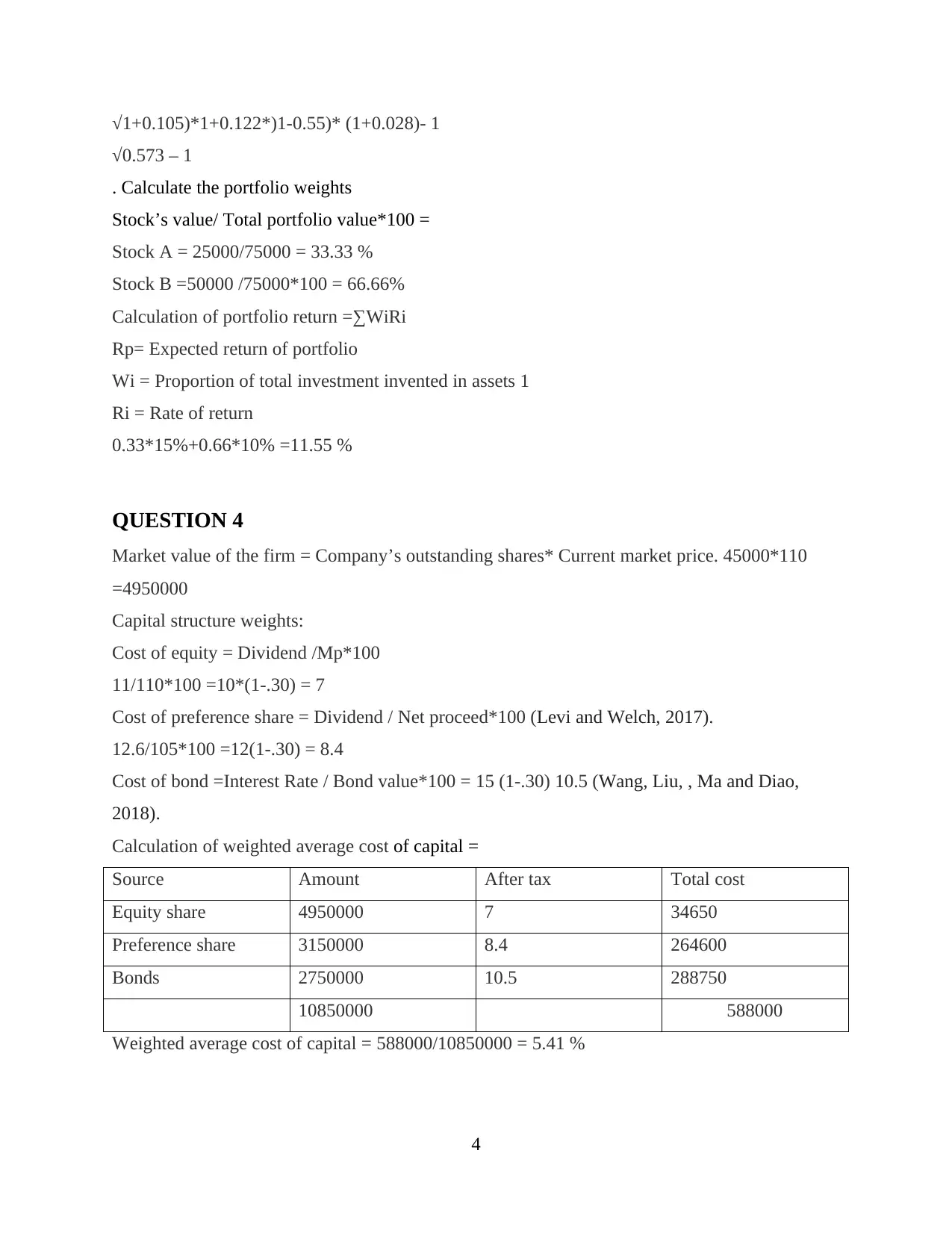
√1+0.105)*1+0.122*)1-0.55)* (1+0.028)- 1
√0.573 – 1
. Calculate the portfolio weights
Stock’s value/ Total portfolio value*100 =
Stock A = 25000/75000 = 33.33 %
Stock B =50000 /75000*100 = 66.66%
Calculation of portfolio return =∑WiRi
Rp= Expected return of portfolio
Wi = Proportion of total investment invented in assets 1
Ri = Rate of return
0.33*15%+0.66*10% =11.55 %
QUESTION 4
Market value of the firm = Company’s outstanding shares* Current market price. 45000*110
=4950000
Capital structure weights:
Cost of equity = Dividend /Mp*100
11/110*100 =10*(1-.30) = 7
Cost of preference share = Dividend / Net proceed*100 (Levi and Welch, 2017).
12.6/105*100 =12(1-.30) = 8.4
Cost of bond =Interest Rate / Bond value*100 = 15 (1-.30) 10.5 (Wang, Liu, , Ma and Diao,
2018).
Calculation of weighted average cost of capital =
Source Amount After tax Total cost
Equity share 4950000 7 34650
Preference share 3150000 8.4 264600
Bonds 2750000 10.5 288750
10850000 588000
Weighted average cost of capital = 588000/10850000 = 5.41 %
4
√0.573 – 1
. Calculate the portfolio weights
Stock’s value/ Total portfolio value*100 =
Stock A = 25000/75000 = 33.33 %
Stock B =50000 /75000*100 = 66.66%
Calculation of portfolio return =∑WiRi
Rp= Expected return of portfolio
Wi = Proportion of total investment invented in assets 1
Ri = Rate of return
0.33*15%+0.66*10% =11.55 %
QUESTION 4
Market value of the firm = Company’s outstanding shares* Current market price. 45000*110
=4950000
Capital structure weights:
Cost of equity = Dividend /Mp*100
11/110*100 =10*(1-.30) = 7
Cost of preference share = Dividend / Net proceed*100 (Levi and Welch, 2017).
12.6/105*100 =12(1-.30) = 8.4
Cost of bond =Interest Rate / Bond value*100 = 15 (1-.30) 10.5 (Wang, Liu, , Ma and Diao,
2018).
Calculation of weighted average cost of capital =
Source Amount After tax Total cost
Equity share 4950000 7 34650
Preference share 3150000 8.4 264600
Bonds 2750000 10.5 288750
10850000 588000
Weighted average cost of capital = 588000/10850000 = 5.41 %
4
Paraphrase This Document
Need a fresh take? Get an instant paraphrase of this document with our AI Paraphraser
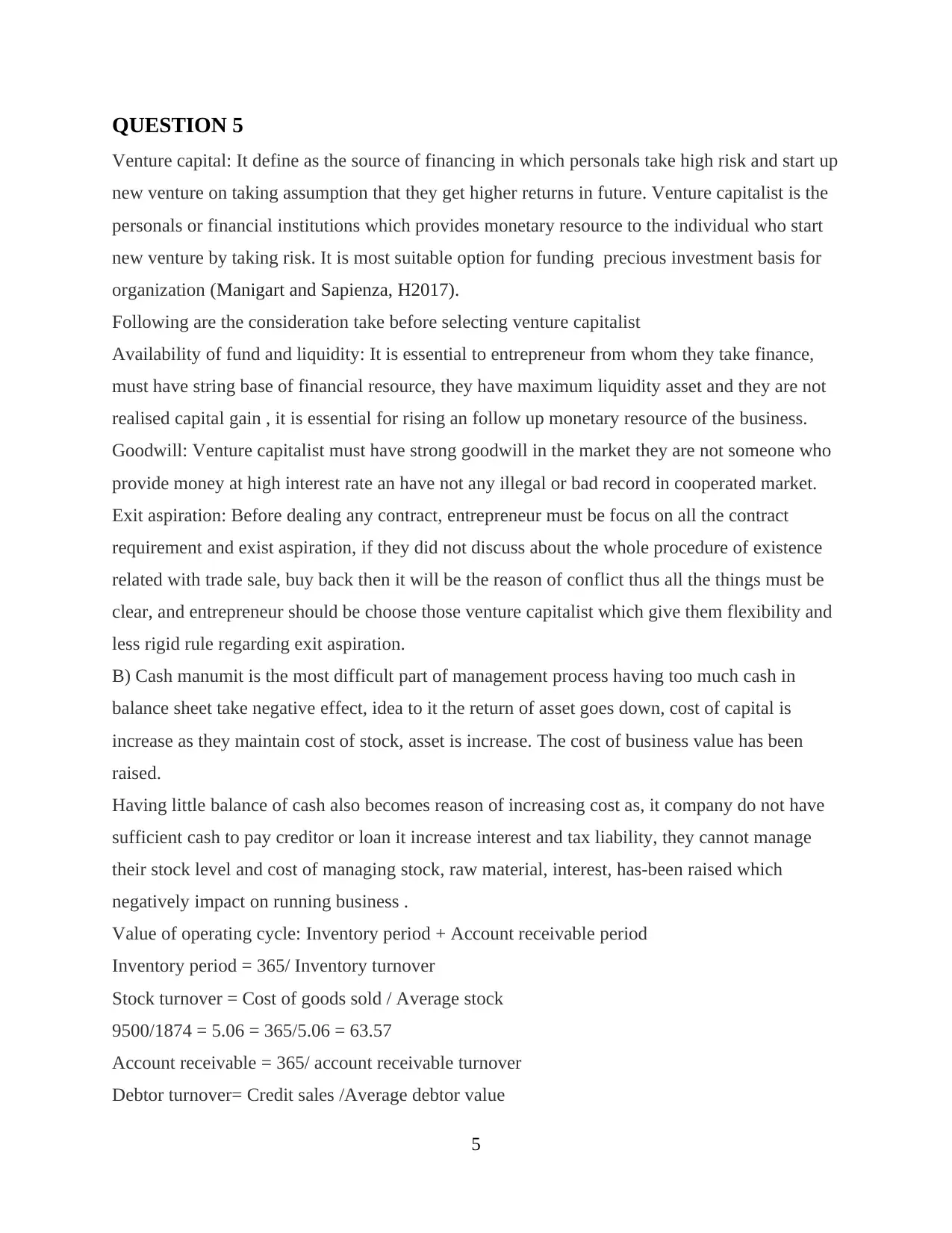
QUESTION 5
Venture capital: It define as the source of financing in which personals take high risk and start up
new venture on taking assumption that they get higher returns in future. Venture capitalist is the
personals or financial institutions which provides monetary resource to the individual who start
new venture by taking risk. It is most suitable option for funding precious investment basis for
organization (Manigart and Sapienza, H2017).
Following are the consideration take before selecting venture capitalist
Availability of fund and liquidity: It is essential to entrepreneur from whom they take finance,
must have string base of financial resource, they have maximum liquidity asset and they are not
realised capital gain , it is essential for rising an follow up monetary resource of the business.
Goodwill: Venture capitalist must have strong goodwill in the market they are not someone who
provide money at high interest rate an have not any illegal or bad record in cooperated market.
Exit aspiration: Before dealing any contract, entrepreneur must be focus on all the contract
requirement and exist aspiration, if they did not discuss about the whole procedure of existence
related with trade sale, buy back then it will be the reason of conflict thus all the things must be
clear, and entrepreneur should be choose those venture capitalist which give them flexibility and
less rigid rule regarding exit aspiration.
B) Cash manumit is the most difficult part of management process having too much cash in
balance sheet take negative effect, idea to it the return of asset goes down, cost of capital is
increase as they maintain cost of stock, asset is increase. The cost of business value has been
raised.
Having little balance of cash also becomes reason of increasing cost as, it company do not have
sufficient cash to pay creditor or loan it increase interest and tax liability, they cannot manage
their stock level and cost of managing stock, raw material, interest, has-been raised which
negatively impact on running business .
Value of operating cycle: Inventory period + Account receivable period
Inventory period = 365/ Inventory turnover
Stock turnover = Cost of goods sold / Average stock
9500/1874 = 5.06 = 365/5.06 = 63.57
Account receivable = 365/ account receivable turnover
Debtor turnover= Credit sales /Average debtor value
5
Venture capital: It define as the source of financing in which personals take high risk and start up
new venture on taking assumption that they get higher returns in future. Venture capitalist is the
personals or financial institutions which provides monetary resource to the individual who start
new venture by taking risk. It is most suitable option for funding precious investment basis for
organization (Manigart and Sapienza, H2017).
Following are the consideration take before selecting venture capitalist
Availability of fund and liquidity: It is essential to entrepreneur from whom they take finance,
must have string base of financial resource, they have maximum liquidity asset and they are not
realised capital gain , it is essential for rising an follow up monetary resource of the business.
Goodwill: Venture capitalist must have strong goodwill in the market they are not someone who
provide money at high interest rate an have not any illegal or bad record in cooperated market.
Exit aspiration: Before dealing any contract, entrepreneur must be focus on all the contract
requirement and exist aspiration, if they did not discuss about the whole procedure of existence
related with trade sale, buy back then it will be the reason of conflict thus all the things must be
clear, and entrepreneur should be choose those venture capitalist which give them flexibility and
less rigid rule regarding exit aspiration.
B) Cash manumit is the most difficult part of management process having too much cash in
balance sheet take negative effect, idea to it the return of asset goes down, cost of capital is
increase as they maintain cost of stock, asset is increase. The cost of business value has been
raised.
Having little balance of cash also becomes reason of increasing cost as, it company do not have
sufficient cash to pay creditor or loan it increase interest and tax liability, they cannot manage
their stock level and cost of managing stock, raw material, interest, has-been raised which
negatively impact on running business .
Value of operating cycle: Inventory period + Account receivable period
Inventory period = 365/ Inventory turnover
Stock turnover = Cost of goods sold / Average stock
9500/1874 = 5.06 = 365/5.06 = 63.57
Account receivable = 365/ account receivable turnover
Debtor turnover= Credit sales /Average debtor value
5
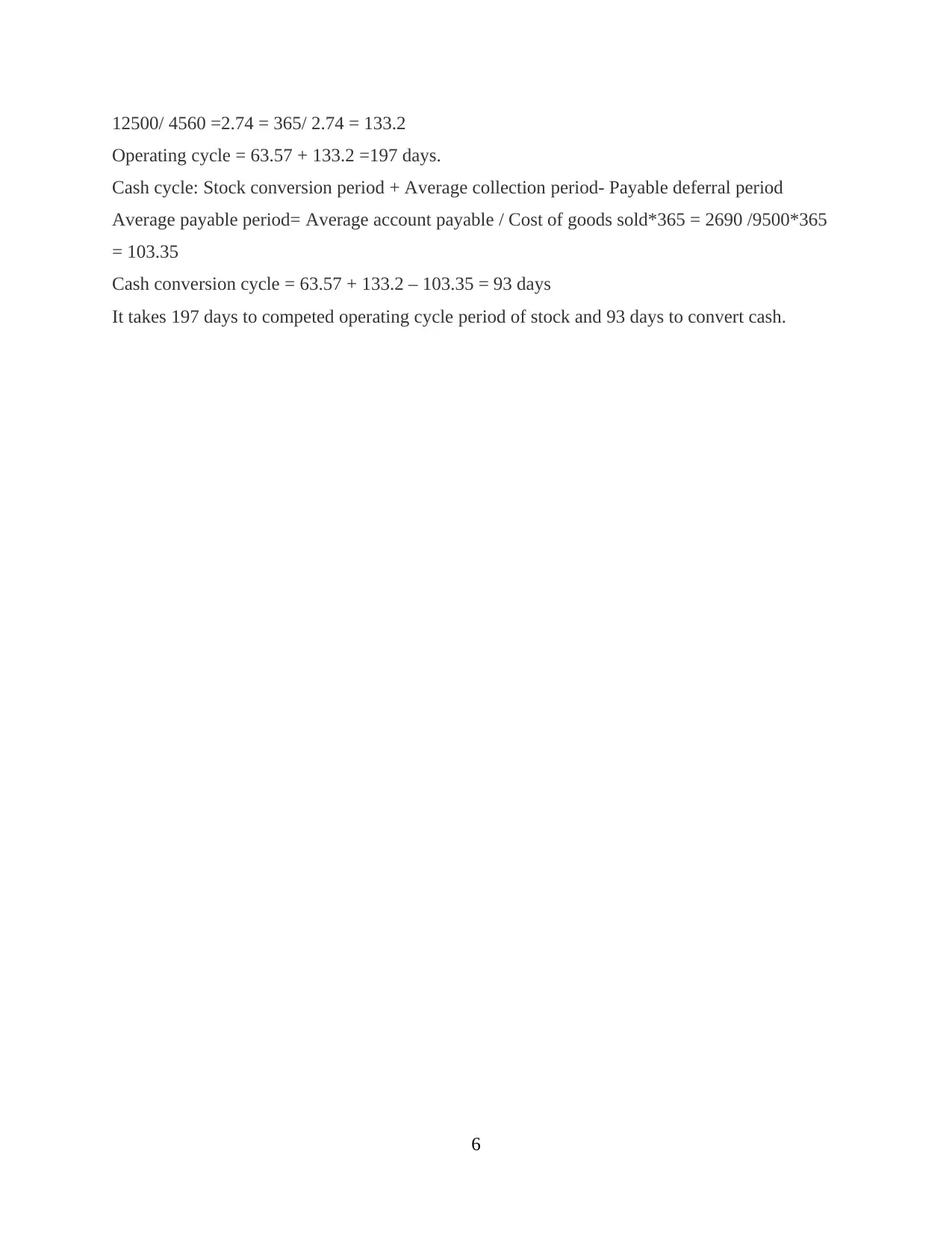
12500/ 4560 =2.74 = 365/ 2.74 = 133.2
Operating cycle = 63.57 + 133.2 =197 days.
Cash cycle: Stock conversion period + Average collection period- Payable deferral period
Average payable period= Average account payable / Cost of goods sold*365 = 2690 /9500*365
= 103.35
Cash conversion cycle = 63.57 + 133.2 – 103.35 = 93 days
It takes 197 days to competed operating cycle period of stock and 93 days to convert cash.
6
Operating cycle = 63.57 + 133.2 =197 days.
Cash cycle: Stock conversion period + Average collection period- Payable deferral period
Average payable period= Average account payable / Cost of goods sold*365 = 2690 /9500*365
= 103.35
Cash conversion cycle = 63.57 + 133.2 – 103.35 = 93 days
It takes 197 days to competed operating cycle period of stock and 93 days to convert cash.
6
⊘ This is a preview!⊘
Do you want full access?
Subscribe today to unlock all pages.

Trusted by 1+ million students worldwide
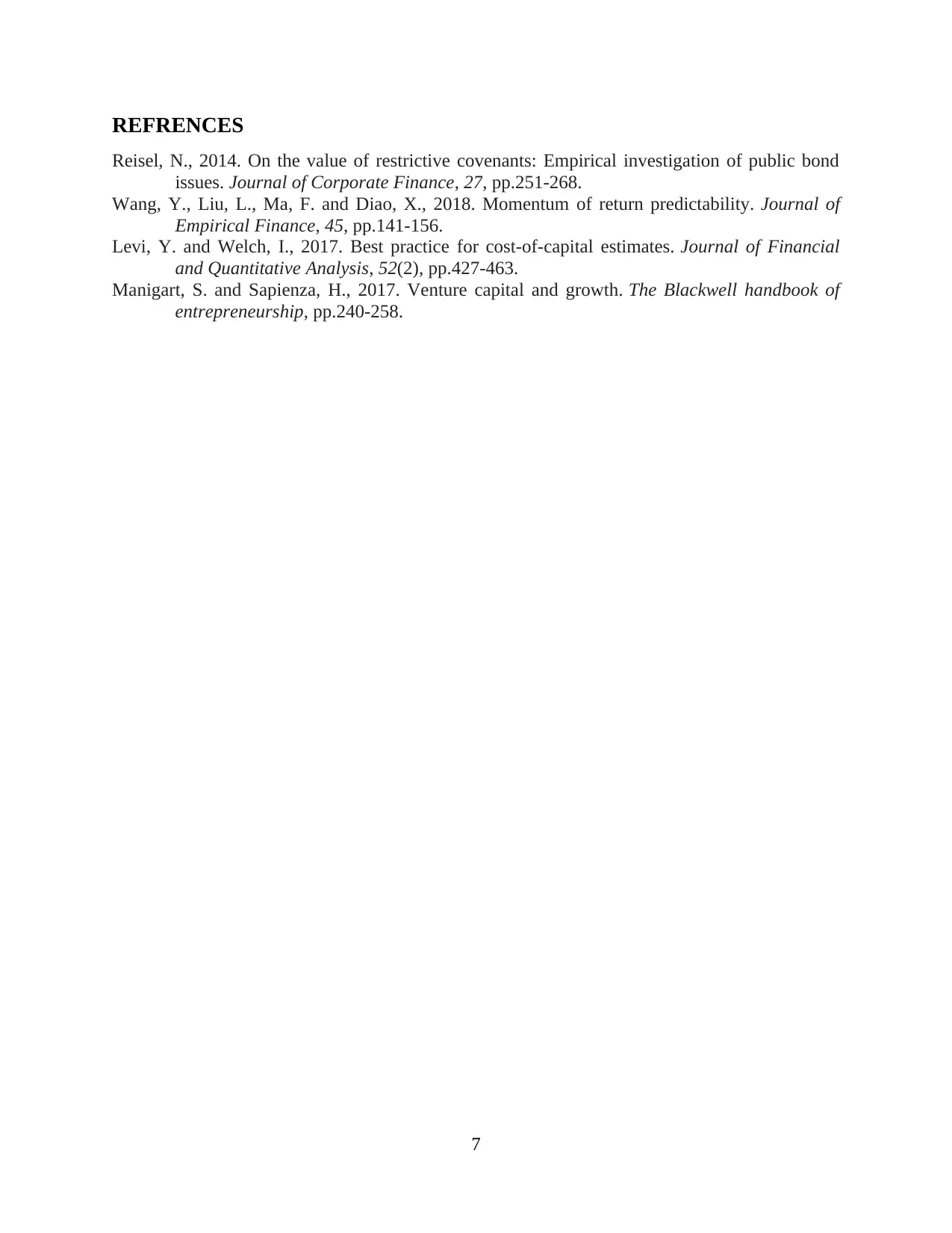
REFRENCES
Reisel, N., 2014. On the value of restrictive covenants: Empirical investigation of public bond
issues. Journal of Corporate Finance, 27, pp.251-268.
Wang, Y., Liu, L., Ma, F. and Diao, X., 2018. Momentum of return predictability. Journal of
Empirical Finance, 45, pp.141-156.
Levi, Y. and Welch, I., 2017. Best practice for cost-of-capital estimates. Journal of Financial
and Quantitative Analysis, 52(2), pp.427-463.
Manigart, S. and Sapienza, H., 2017. Venture capital and growth. The Blackwell handbook of
entrepreneurship, pp.240-258.
7
Reisel, N., 2014. On the value of restrictive covenants: Empirical investigation of public bond
issues. Journal of Corporate Finance, 27, pp.251-268.
Wang, Y., Liu, L., Ma, F. and Diao, X., 2018. Momentum of return predictability. Journal of
Empirical Finance, 45, pp.141-156.
Levi, Y. and Welch, I., 2017. Best practice for cost-of-capital estimates. Journal of Financial
and Quantitative Analysis, 52(2), pp.427-463.
Manigart, S. and Sapienza, H., 2017. Venture capital and growth. The Blackwell handbook of
entrepreneurship, pp.240-258.
7
1 out of 7
Related Documents
Your All-in-One AI-Powered Toolkit for Academic Success.
+13062052269
info@desklib.com
Available 24*7 on WhatsApp / Email
![[object Object]](/_next/static/media/star-bottom.7253800d.svg)
Unlock your academic potential
Copyright © 2020–2025 A2Z Services. All Rights Reserved. Developed and managed by ZUCOL.




